作者: admin
Trump sent three tweets in a row and was criticized for racism!
BEIJING, July 15 (Bian Lei) Recently, US President Trump was once again criticized for "saying the wrong thing".
This time, Trump’s remarks were accused of racism, and House Speaker Pelosi even said that the president hoped to "make America change again ‘ White ’ " .

[What did Trump say? 】
On July 14, Trump sent three tweets on the social networking site "Twitter", which caused public outrage:
"See these ‘ Progress ’ It’s really interesting that women members of the Democratic Party originally came from completely broken countries, which are the worst, most corrupt and incompetent countries in the world … …”
"The United States is the greatest and most powerful country on earth. Now, they are telling the American people loudly and with hostility how the government should operate. Why don’t they go back to help their completely broken and crime-ridden motherland? "
"Then come back and tell us how they did it. Those places need their help so badly that they can’t leave quickly. I believe Pelosi is happy to make free travel arrangements quickly! "
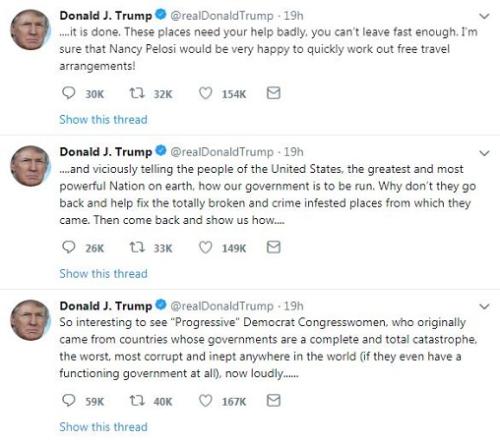
The Associated Press said that Trump’s remarks were directed at four female members of the Democratic minority. Last week, two of them also condemned the poor conditions in the immigration detention camp on the US-Mexico border.
However, these four people are not from a "broken country" as Trump said. Only Congressman Omar was born overseas, and the remaining three people, Presley, Cortes and Treb, are all native-born Americans. Omar and Treeb are also two Islamic women who served as members of the House of Representatives for the first time in the history of the US Congress.
Some American media asked the White House to confirm whether Trump knew the situation of these four people, but the White House has not yet responded.
In fact, this is not the first time Trump has been approved to hold a "racist" view. At the beginning of his political career, he claimed that Obama was not born in the United States. In 2015, when Trump launched the presidential campaign, he even called Mexican immigrants "rapists".

[Triggering a swarm again]
In fact, the four Democrats named by Trump have recently become the focus of media attention because they disagree with Pelosi. Earlier, Pelosi wanted to reduce the influence of one of the ethnic minority parliamentarians, who accused her of this move to marginalize ethnic minority women.
On July 12th, Trump rarely defended Pelosi, calling her "not a racist". However, Pelosi did not appreciate it. After Trump sent the above three tweets on the 14th, she quickly pointed her finger at Trump.
Pelosi said that Trump’s remarks were xenophobic and "aimed at splitting our country" and "once again confirmed his plan to make America great again, that is, to make America change again ‘ White ’ " .
At the same time, the "detained" members were not to be outdone and quickly condemned Trump’s remarks.
Cortes said: "Mr. President, the country where I come from and the country where we took the oath are both the United States." "You are angry because you can’t imagine an America that can tolerate us. You rely on a frightened America to realize your plunder. "

Another party, Presley, posted a screenshot of Trump’s tweet and said, "This is what racism looks like … … We’re not going anywhere. In addition to returning to Washington, fight for those families who are marginalized and slandered by you. "

In addition, on social networking sites, someone created a topic tag of "# trumpisarist", which attracted the attention of netizens. Some netizens even thought that the first lady Melania was born overseas (Slovenian), and "hit back" Trump’s words and deeds.
What is the intention of Trump’s remarks? Some commentators said that it was to further divide the disputes within the Democratic Party when these female parliamentarians and Pelosi had different political views.
However, this move did not seem to be effective, but contributed to the unity of the Democratic Party: Democrats in the House of Representatives all supported the four female members, claiming that Trump’s speech repeated his "xenophobic" remarks about other non-white immigrants.
[torn America]
The turmoil caused by Trump’s three tweets has also brought the topic of racism in the United States back to people’s sight.
The New York Times issued a document on the 14th saying that "Trump’s tweet proves that he is an angry racist"; CNN also commented on the 15th that Trump’s latest public racist remarks are not surprising at all.
"Unfortunately, the United States has such a tradition of telling people to go back where they came from," new york Mayor Bill de Blasio, a Democratic presidential candidate, said in an interview with CNN on 14th. "But you don’t want to hear these words from the president.".
The United States is a multi-racial and multicultural country composed of immigrants, but since the first batch of African blacks were transported to the New World in 1619, the problem of racial discrimination has been deeply rooted.
In recent years, the former owner of the NBA Clippers was forced to sell his team because of his alleged racism. Luxury brands Prada and Gucci were boycotted by Hollywood directors; Biden, the US presidential candidate and Democratic Congressman, has a declining support rate … …
On the whole, ethnic minorities are still vulnerable in the United States, and racist violence and demonstrations have long existed. According to the data released by the FBI at the end of 2018, hate crimes in the United States have increased for three consecutive years, and the most common motive is hatred of race or descent.
Some media even pointed out that the recent US government’s iron-fisted measures against American and Mexican immigrants and the encirclement and interception of illegal immigrants are further tearing the United States and becoming an irreparable pain.
Will the trauma of racism in the United States be further deepened? People are worried.
How chilling is Karry’s blog deletion? The studio announced that it would suspend its participation in the recording.
1905 movie network news In the second season of "High-Energy Youth League", due to malicious editing by the program group, Karry fans were dissatisfied, and the studio issued a statement asking for an apology and correction for breach of contract and damage to the artist’s image, but there was still no response.
While waiting for the program group to respond fruitlessly, Karry Studio was forced to speak again, saying, "We wait for the above problems to be solved with sincere cooperation. Therefore, Karry will first suspend the recording to chengdu railway station. Please do not speculate. "
On April 29th, Karry himself deleted the propaganda of Weibo, and showed his attitude with actions. This is also the first time that Karry has deleted her partner to promote Weibo since her debut five years ago. As a party, showing such a firm attitude also shows the authenticity of the program group’s "ensuring everything is true" from the side.
It is reported that Karry just finished his overseas trip before he participated in the recording of the first issue of the second season of High Energy, and left for Manzhouli to participate in the recording the next day. Karry’s earnest efforts and hard work were maliciously edited and innocently planted by the program group, which was chilling.
Many netizens also expressed their support for Karry’s blog deletion. The message said: "It’s really handsome, cool boy", "Good deletion" and "Support Karry’s younger brother". "Karry is too sue to stand with fans, and the fans’ confidence comes from Aidou himself".
Young people choose the first car, ARCFOX, which is crazy.
The richness of the configuration is closely linked to the cost performance of a car, and many people have mentioned it. Next, let’s take a look with Xiaobian.
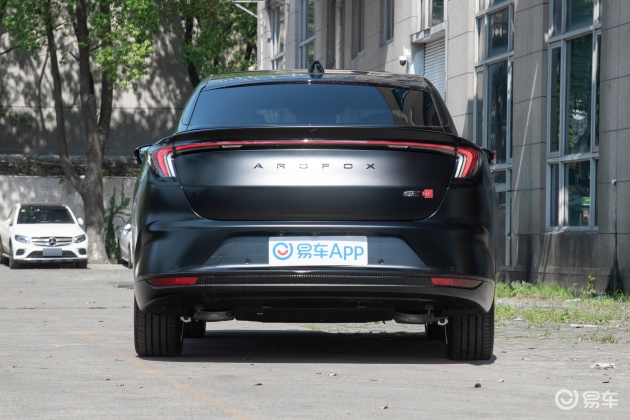
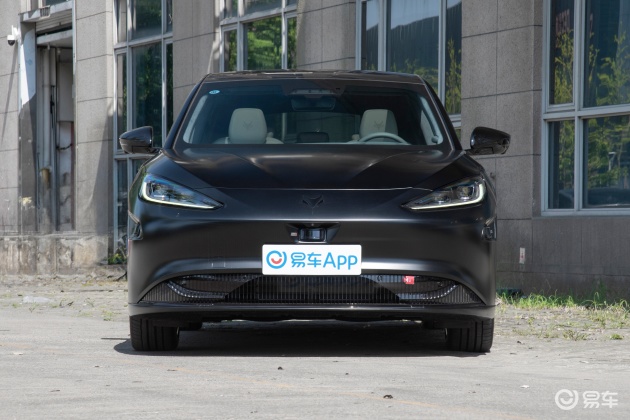
Let’s take a look at the appearance of the extreme fox Alpha S. The front face of the extreme fox Alpha S gives people a very simple feeling and looks cold. Coupled with the domineering headlights, the visual effect coincides with the positioning of the whole vehicle. The car is equipped with LED daytime running lights, automatic opening and closing, adaptive far and near light, automatic steering, delayed closing and so on. Coming to the side of the car body, the size of the car body is 4980MM*1960MM*1599MM, and the car body looks very round with large-sized thick-walled tires, which looks full of movement. In the rear part, the tail line of the extreme fox Alpha S is atmospheric, and the taillights give people a very cool feeling, and the overall shape is still very attractive.


When I came to the Extreme Fox Alpha S car, the interior shape of the Extreme Fox Alpha S was relatively simple, and the overall design of the gas field was still in place. The steering wheel of the car is very round and made of leather, which looks a bit more eye-catching. From the central control point of view, the central control screen with 21.7-inch touch-sensitive LCD makes the interior style impressive and looks cute. The dashboard and seats give people a good feeling, too. Let’s take a look. The dashboard of this car presents a delicate design style, which highlights the trendy temperament. The car adopts imitation leather seats, and the seat wrapping is in place, and the overall comfort and wrapping are not bad.
The polar fox Alpha S is 252KW, the total torque is 370N.m, and the maximum speed is 200 km/h..

The space performance of the Extreme Fox Alpha S trunk is quite satisfactory, but it supports the rear seats to be laid down, which greatly improves the expansion of the space and meets the daily travel needs. At the same time, the car is equipped with fatigue warning, anti-lock braking (ABS), LED daytime running lights, brake assist (EBA/BAS, etc.), brake force distribution (EBD) main driver airbag, co-pilot airbag, side airbag curtain, front side airbag and other safety configurations.

I wonder if you are excited about this car introduced today? You can learn more about what you like!
Yu Chengdong: Zhijie R7 opens a small order, the pre-sale price starts from 268,000 yuan
according toFinancial Union news on September 10, Huawei managing director, chairperson of end point BG, intelligent car solutions BU chairperson Yu Chengdong said today, intelligent R7 open small order, pre-sale price 268,000 yuan. Yu Chengdong also said that intelligent R7 will exceed the Model X specifications cross-level competition Model Y.
Online consumption preference increased in October, and investment in fixed assets maintained steady growth | high frequency macro
The National Bureau of Statistics recently released economic data for October. In terms of consumption, the total retail sales of social consumer goods in October was 4,027.10 billion yuan, down 0.5% year-on-year; Cumulatively, from January to October, it increased by 0.6% year-on-year, which was 0.1 percentage point slower than last month. The consumption situation in October showed that the market demand was insufficient, and more offline consumption turned to online. According to Wind’s data, nearly two-thirds of the sample cities (the sample is 29 cities that continue to count subway passenger traffic in Wind database) have a decrease in the average number of daily trips in October compared with September; At the same time, the e-commerce "Double Eleven" activity was launched in the same month. In October, the retail sales of online goods and services increased by 4.9% year-on-year, and the growth rate was 0.9 percentage points faster than that of the previous month. The cumulative online retail sales of physical goods accounted for 26.2% of the total retail sales of consumer goods, the highest in recent years. On the whole, however, the current market consumption willingness is still insufficient, which is also reflected in the negative short-term RMB loans added by residents and enterprises (institutions) in that month (-51.200 billion yuan and-184.300 billion yuan respectively).
The adaptation time of the National General Software and Hardware Research and Adaptation Center was shortened from 6 months to 1 month.
Xinchuang is the application innovation of information technology. The application and innovation industries of information technology such as chips, servers, operating systems and databases are the key industries to promote the integrated application of independent technologies such as integrated circuits and communications.
Recently, the general software and hardware adaptation certification center in Xinchuang field, which was started by the Ministry of Industry and Information Technology and Beijing, was officially put into use, which will further accelerate the localization process of software and hardware products in the information technology field.
The research and adaptation center of general software and hardware is located in Xinchuang Park, Beijing Economic Development Zone, the core base of national information technology application and innovation. In this adaptation center, the time for an application to adapt to the operating system can be shortened from the previous six months to one month now.

Tan Chang, Manager of Industry Promotion Department of National Xinchuangyuan in Beijing Economic Development Zone:Because every enterprise has many adaptive schemes for chips, operating systems, databases and applications. Then we use a platform to solve these common problems, so that enterprises can save time, resources and funds, and put more energy into the research and development of new products and technologies.

The National Adaptation Certification Center has built a public adaptation support platform and improved the adaptation ecosystem through unified adaptation standards, unified evaluation system and unified ecological services. Here, 85 key enterprises in the field of Xinchuang concentrate on tackling key core technologies, forging the long board of industrial chain supply chain and filling the short board of industrial chain supply chain.

Zhang Lei, the person in charge of the enterprises in the park:After we have a new system or a new product here, or a new specification, other partners can align in the planning. In this way, before the product is released, all the work has been done, from soft to hard, from top to bottom, forming a very good ecology. Only in this way can the whole industry prosper.

At present, China is accelerating the development of a new generation of information technology industry that is autonomous, controllable, safe and efficient. It is understood that with the further improvement of the innovation ability of China’s innovation industry, it is expected to release the trillion-dollar market scale by 2030.
(Editor Tao Mengqi)
New formats and new models drive new trends, low-altitude economy "flies into the homes of ordinary people" and builds a three-dimensional city.
CCTV News:Low-altitude economy is a national strategic emerging industry and a typical representative of new quality productivity. Developing low-altitude economy is an important measure to shape new development momentum and advantages and create a new engine for economic growth. In the past two days, Beijing has issued an action plan to promote the high-quality development of low-altitude economic industries and publicly solicited opinions from the society. The plan proposes that Beijing plans to open low-altitude routes for surrounding areas.

According to the "Draft for Comment", by 2027, Beijing will add more than 10 application scenarios around emergency rescue, logistics and distribution, air ferry, inter-city logistics and special cultural tours, and open more than 3 low-altitude routes facing the surrounding areas, and basically build a networked infrastructure system and low-altitude application ecology. In terms of inter-city communication, commuter routes between Daxing Airport and xiong’an new area, Capital Airport and Tianjin, Langfang and other regions will be established, and a new application format of "split flying car inter-city communication+inter-city ferry" will be explored; In terms of characteristic cultural tourism, we will develop low-altitude tourism, flight experience and other industries in Yanqing, Pinggu and Miyun.

In accelerating the exploration of new modes of low-altitude economy in Beijing, the Draft for Comment also sets specific development goals — — Strive to pass three years, the number of low-altitude economy-related enterprises will exceed 5,000, driving the city’s economic growth to exceed 100 billion yuan.
Low-altitude economy "take-off": building three-dimensional city low-altitude traffic into residents’ lives
In recent years, many places in China, including Guangdong, Anhui and Hunan, have laid out the track of low-altitude economy, and even entered the lives of residents. Watching the city scenery in the air, flying to work, drones as "couriers", etc., the city has become more three-dimensional.
As "the first pilot province of low-altitude opening in China", Hunan’s low-altitude airspace has been divided into 179 blocks, and flight verification of 97 low-altitude routes has been completed throughout the province.

In Zhuzhou Lusong Airport, you can see manned light aircraft and research and tourism teams coming and going frequently every day.
The reporter also experienced an air flight, taking off from Zhuzhou Lusong Airport, and after a flight time of about 5 minutes, he arrived in the urban area. On the plane, you can also see Xiangjiang River and Zhuzhou TV Tower. In addition to enjoying the city scenery in all directions in the air, the reporter also has a feeling that it is fast, because it took about 40 minutes to drive from the urban area to the airport in the morning, and now it takes only 5 minutes to fly from the airport to the urban area.

At the end of April this year, Hunan officially opened the first normalized low-altitude logistics application route. On the top floor of a commercial plaza in Changsha County, with the instructions of the delivery personnel, a drone with a load of 4.5 kilograms "hugged" the goods that the customer had just placed and flew to the destination several kilometers away at a cruising speed of 60 kilometers per hour.

At present, Changsha county has opened three instant retail routes, and the delivery time within 5 kilometers will not exceed 10 minutes. The delivery cost is determined according to the length of the route and the weight of the goods, basically every order is 5-mdash; 10 yuan’s interval.

In Anhui, the low-altitude travel and commuting routes from Hefei to Huangshan run once a day, and the journey takes only one and a half hours. A single-engine turboprop plane can accommodate six passengers except the crew, and the flying height of the whole flight is about 3000 meters.

In addition to low-altitude travel between cities, in Luogang Park in Hefei, low-altitude short-distance commuting in the city is gradually becoming a reality. At the end of last year, the world’s first unmanned manned aircraft with airworthiness certificate successfully completed its first commercial flight demonstration in Luogang Park. The flight distance of the aircraft with a full charge of electricity is 30 kilometers and the flight time is 25 minutes. In the cruising state, the flying height of the aircraft is about 50 meters and the flying speed is 40 kilometers per hour. At present, Hefei is gradually building a demonstration benchmark for commercial operation of unmanned manned aircraft, and projects such as low-altitude sightseeing, park connection and commercial customized services of unmanned manned aircraft will be further developed.
"internet plus" Let the old-for-new front-end speed-up digital platform improve the efficiency of resource recycling
CCTV News:In order to promote green development and stable economic growth, in 2024, the National People’s Congress proposed to promote the trade-in of consumer goods and boost service consumption. How to make it easier for people to get rid of the old and be more willing to change? Lin ‘an District, Hangzhou City, Zhejiang Province has launched a small online recycling program for all kinds of goods.


It is the staff of renewable resources network who are teaching Ms. Chen how to use the online recycling applet. Because old electrical appliances are too heavy and the distribution of outlets is uneven, it used to be difficult for many citizens, especially the elderly, to deal with them. Now, as long as you click on your mobile phone, professionals will come to your door within half an hour.

It is understood that at present, Lin ‘an has set up a total of 406 renewable resource outlets, relying on the digital platform to improve the efficiency of resource recycling and continue to accelerate the pace of trade-in.
Extended interpretation: announcement of the list of key industries for equipment renewal and transformation
The Action Plan for Promoting Large-scale Equipment Renewal and Trade-in of Consumer Goods (hereinafter referred to as the Action Plan) was officially announced a few days ago. The plan proposes that in order to promote the upgrading of equipment in key industries, which industries and fields will be included in the Action Plan?

The "Action Plan" proposes to focus on key industries such as steel, nonferrous metals, petrochemicals, chemicals, building materials, electricity, machinery, aviation, shipbuilding, textiles and electronics, and vigorously promote the renewal and technological transformation of production equipment, energy-using equipment, power generation and transmission and distribution equipment.

Focusing on the construction of new urbanization, we will speed up the upgrading of equipment in the fields of construction and municipal infrastructure. Among them, residential elevators, water supply, heat supply, gas supply, sewage treatment, sanitation, urban lifeline engineering, security and so on in urban renewal and old residential area reconstruction are the key points.

In terms of transportation equipment, we will continue to promote the electrification of urban buses and support the upgrading of old new energy buses and power batteries. Accelerate the elimination of diesel trucks operating under national emission standards III and below. Combined with the needs of agricultural production and the level of agricultural mechanization development, we will promote the scrapping and updating of old agricultural machinery.

In addition to industrial and agricultural production equipment, educational, cultural and medical equipment has also been included in the scope of a new round of large-scale equipment update. Encourage qualified medical institutions to speed up the renovation of medical equipment such as medical imaging, radiotherapy, remote diagnosis and treatment, and surgical robots. In addition, it will also promote the upgrading of cultural tourism equipment such as ropeways, cable cars, amusement equipment and performing arts equipment.

According to the goal proposed in the plan, by 2027, the scale of equipment investment in the fields of industry, agriculture, construction, transportation, education, cultural tourism and medical care will increase by more than 25% compared with 2023. The energy efficiency of major energy-using equipment in key industries has basically reached the level of energy saving, and the proportion of production capacity with environmental protection performance reaching Grade A has been greatly improved. The penetration rate of digital R&D design tools and the numerical control rate of key processes of industrial enterprises above designated size have exceeded 90% and 75% respectively.
Extended interpretation: carrying out trade-in of automobile and household appliances.
In the Action Plan for Promoting Large-scale Equipment Renewal and Trade-in of Consumer Goods, it is also proposed that which consumer goods are expected to be selected and what favorable measures will be taken to implement the trade-in of consumer goods?
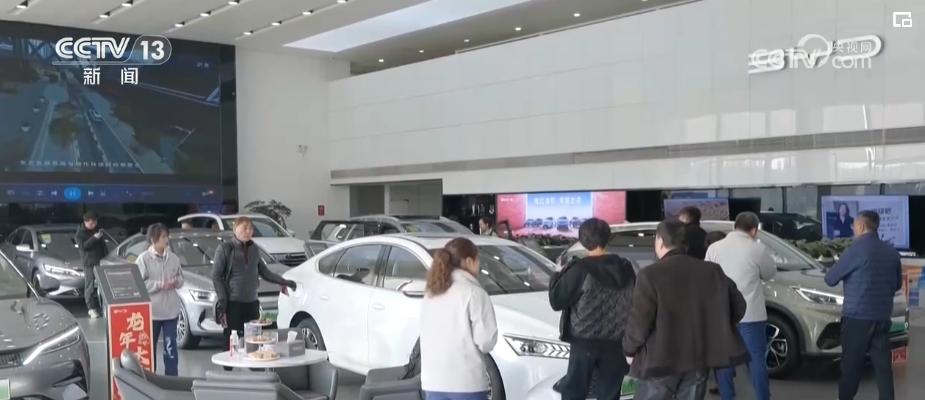
According to the "Action Plan", the state will increase policy support and organize national automobile trade-in promotion activities. At the same time, strict enforcement of motor vehicle compulsory scrapping standards and vehicle safety and environmental protection inspection standards, elimination of old cars that meet compulsory scrapping standards according to laws and regulations, and optimization of automobile purchase restriction measures according to local conditions.
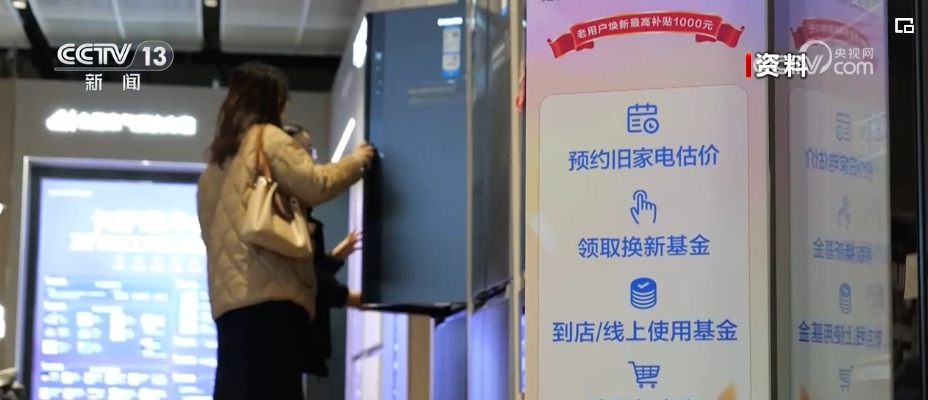
Support home appliance sales enterprises, joint production enterprises and recycling enterprises to carry out trade-in promotion activities, open online and offline home appliance trade-in areas, and give preferential treatment to consumers who exchange old home appliances for energy-saving home appliances. Encourage qualified places to subsidize consumers to buy green smart home appliances.

The "Action Plan" proposes that it will also promote the replacement of home improvement consumer goods. Through various ways such as government support and profit-making by enterprises, we will support residents to carry out local renovation of old houses, kitchens and bathrooms, continue to promote the aging renovation of homes, and actively cultivate new consumption such as smart homes. Promote home improvement model rooms to enter shopping malls, communities and platforms, encourage enterprises to build online model rooms, and provide affordable products and services to meet diversified consumer needs.
The Secret Interpretation of AT Hydraulic Automatic Transmission (Structure)
[Technical Lecture Hall] At present, equip with hydraulic power.Automatic transmission (hereinafter referred to as AT)The proportion of models is getting bigger and bigger, compared withManual transmission (hereinafter referred to as MT)Model, its convenience is very prominent. In this article and subsequent articles, the editor will take you to interpret all kinds of knowledge of AT in detail, and as the basic part of the beginning, let’s talk about the basic structure and working principle of AT first.
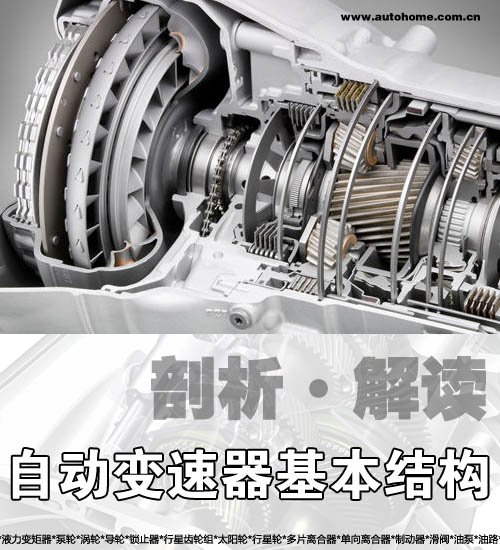
Usually, we call it AT’s automatic transmission. Its core components are:, planetary gear set,/brake and its control mechanism (solenoid valve, oil circuit), and its peripheral equipment is the transmission housing, etc. Let’s start with the hydraulic torque converter in the order of power flow.
● Hydraulic torque converter
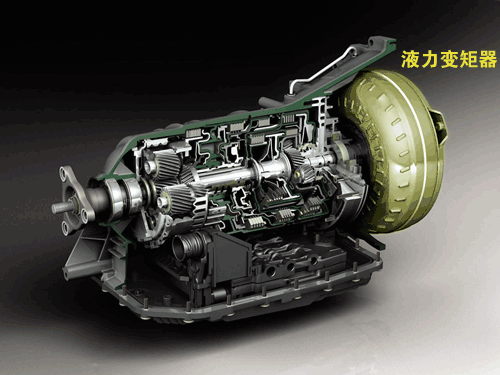
There was a saying that the torque converter on AT was equivalent to the clutch on MT, which played the role of connecting and interrupting power. Actually, this statement is wrong.AT and are directly connected, unlike MT, which has a power switch: clutch. Therefore, from the moment of ignition, the torque converter starts to rotate, and the connection and interruption of power is still completed by the clutch inside the gearbox. The only similarity between the torque converter and the MT clutch, that is, the "soft connection" characteristic of the torque converter, is similar to the "semi-linkage" working condition of the MT clutch.
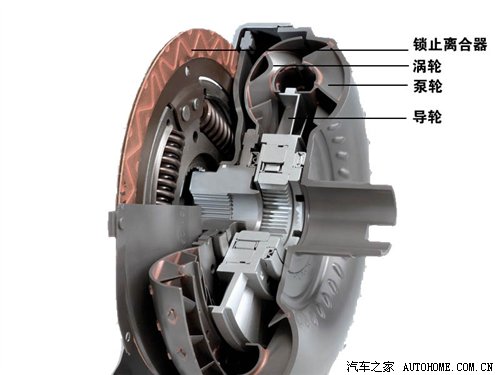
The working principle of hydraulic torque converter is like two fans facing each other. One fan works and then blows the other fan that doesn’t work. This metaphor can vividly explain the working relationship between the pump wheel and the turbine in the hydraulic torque converter. However, explaining its working principle in detail is somewhat complicated.

After power output, the pump wheel connected with the torque converter housing is driven, and the pump wheel stirs the torque converter.Oil (hereinafter referred to as ATF), driving the turbine to rotate, ATF is a circular action in the shell. Due to the centrifugal force when the pump wheel rotates, ATF will be thrown to the outside under the action of the pump wheel, rushing to the turbine in front, then flowing to the axial position and returning to the side of the pump wheel. This cycle will transmit power to the turbine connected to the gearbox.
However, only this component and transmission mode can only be called hydraulic coupler. If you want to become a hydraulic torque converter, you must change the shape of turbine blades. In this way, when ATF is recycled back to the pump wheel through the turbine, it will rotate in the opposite direction to the pump wheel, thus causing impact. Therefore, in order to become a hydraulic torque converter, you need another component: the guide wheel. The guide wheel is a component between the pump wheel and the turbine, which is used to adjust the direction of ATF liquid flow in the housing and is fixed to the housing through a one-way clutch.
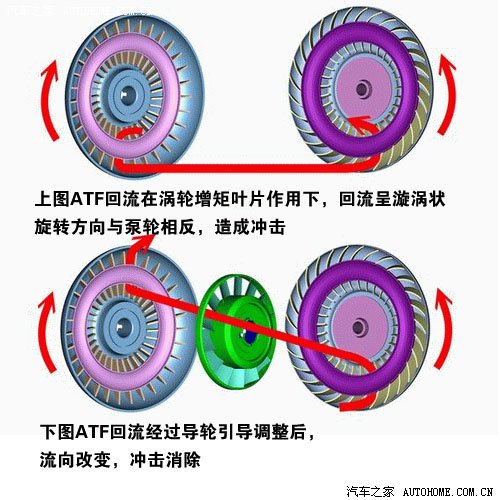
With the guide wheel, there is the soul of "torque change". When the speed difference between the pump wheel and the turbine is large, the power output is also large. At this time, the torque converter wants to be a continuously variable transmission, through the speed difference.Raise the torque, and the guide wheel is in a fixed state at this time., used to adjust ATF reflux; However, when the speed difference is reduced and the turbine impeller is coupled or locked, the torque is close to equivalence.There is no need to increase the torque, and the guide wheel rotates in the same direction as the pump wheel and the turbine.Avoid stirring ATF by yourself, resulting in power loss.
At this point, we have learned the biggest feature of hydraulic torque converter-soft connection, and this power transmission mode has played two major functions: 1. A smooth start from standstill to low speed; 2. In the acceleration process, when the power output is large, it can increase the torque. If compared with the clutch on MT, it should be noted that the first one has played and optimized the function of the clutch on MT, but the second one cannot be realized by the clutch.
However, the inherent "soft connection" feature of hydraulic torque converter has a weakness. The power is not directly output, and the rotation speed of the pump wheel is higher than that of the turbine when the torque output is equivalent. In this case, when transmitting power, ATF still circulates in the shell, wasting power. Therefore, almost all hydraulic torque converters have an efficient and energy-saving component: the hydraulic torque converter lock. The locking device is in the form of a multi-disc clutch, and its function is to lock the pump wheel and the turbine when the torque converter is in a coupled state and there is no need to increase the torque. In this case, the power transmission is a "hard connection", and all the lossless (or a little power loss) will be transmitted from the crankshaft to the next station: the gearbox.
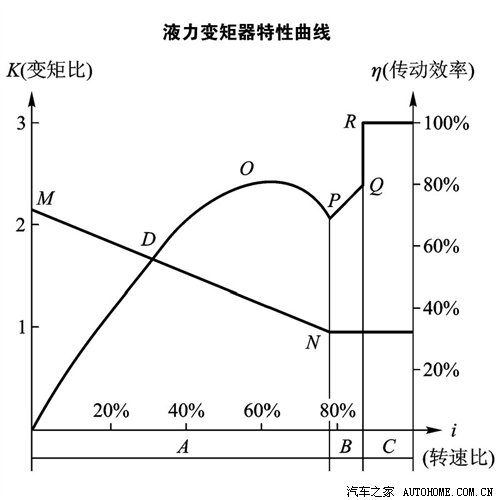
Simply explain the above picture: the I-axis is the speed ratio, indicating the ratio of the speed of the turbine and the pump wheel. The speed of the pump wheel at the left end is much greater than that of the turbine, and the right side is equal. When starting or stepping on the accelerator with big feet, the rotation speed is relatively small, and the pump wheel is much faster than the turbine. At this time, the output torque of the pump wheel is much larger than the input torque of the turbine, which is more powerful, but the transmission efficiency is lower; When stepping on the accelerator lightly, the speed ratio increases, the torque ratio decreases, and the transmission efficiency increases accordingly. When the speed ratio is 60%, the efficiency is the highest. When the throttle is stabilized and the speed is relatively stable, the speed ratio further increases and the torque ratio is close to 1, but the transmission efficiency decreases at this time; In order to avoid power loss, the torque converter is locked with the clutch, and the speed ratio suddenly increases to 1, and the efficiency also reaches the highest.
● Hydraulic torque converter is not a feature of AT.
Hydraulic torque converter is not unique to AT, and some transmissions also use hydraulic torque converter as the mechanism to optimize power. AT does not absolutely use hydraulic torque converter to realize soft connection. For example, the Speedshift MCT automatic transmission used on some AMG models replaces the hydraulic torque converter with a pair of multi-disc clutches. Therefore, the hydraulic torque converter is not the biggest feature of AT, but the planetary gear set working in cooperation with multiple clutches/brakes is the biggest feature of automatic transmission.
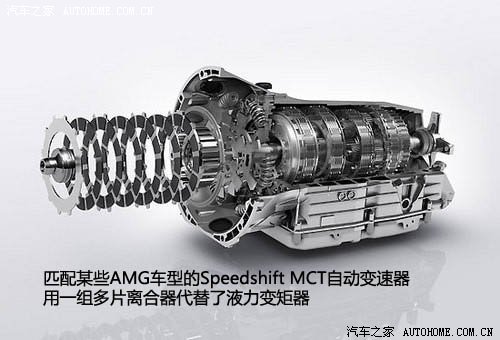
● Planetary gears and planetary gear sets in AT gearbox
On MT, each gear has a set of two normally meshed gear pairs, and only the output shaft needs to be splined with the output gear of that gear to change gears. In AT, not so many gears are working, but a very unique way to complete the transformation: planetary gear sets. Let’s take a look at the characteristics of a basic ternary planetary gear:
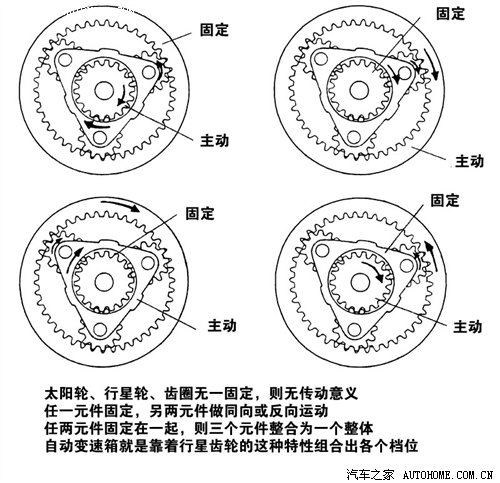

"planetary gear set model"
The biggest characteristic of planetary gears is that after different input and output wheels are combined, the tooth ratio and the relative direction of input and output will change, which is very suitable for automobile transmission. In order to increase the gear, the planetary gears on the car are upgraded to gear sets and gear rows, and then the gear shift can be completed through a series of actuators.
● AT actuator: clutch, one-way clutch and brake.
As we have learned above, what kind of transformation forms a group of planetary gears has, and the components responsible for transformation and input and output are a series of actuators: clutches, one-way clutches and brakes. With these actuators, planetary gears can be combined in different ways to match different power flows and have different transmission ratios. These operations are controlled by the matching oil pump, slide valve, hydraulic pressure and complex hydraulic circuit.
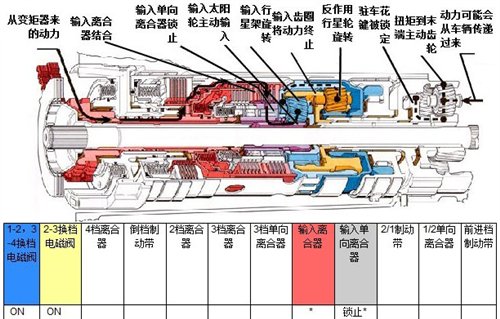
"The picture shows the position and working conditions of each component of the old 4T65E automatic transmission when it is in neutral."
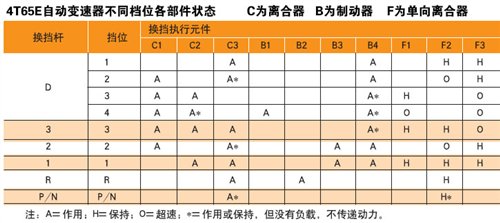
Different gears are formed under different combinations of multiple actuators and planetary gears.
At this point, the power from the engine has been reorganized, and the ever-changing torque and speed are transmitted to the wheels. Compared with MT, the convenience is improved, while the internal structure and working conditions are much more complicated. The structure and principle of AT have been introduced. In the next article, the usage of PRND gear on AT is mainly introduced. (Text/car home Ren Fei)
Related links:
